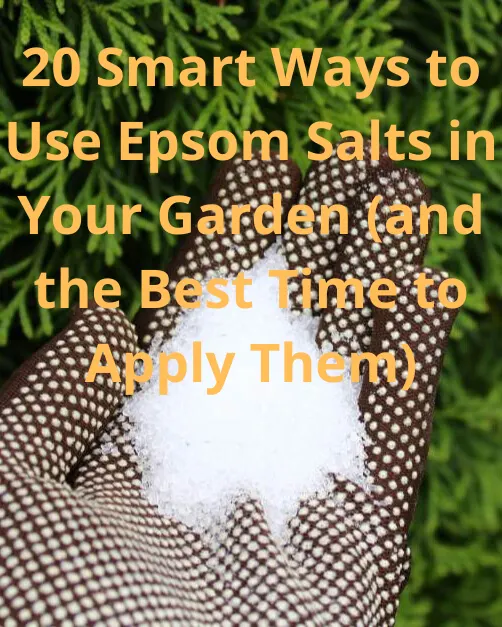IEpsom salt might look like something you’d only keep in your bathroom, but gardeners know it’s a secret weapon for healthy, thriving plants. Rich in magnesium and sulfate, this simple mineral can transform the way your garden grows—from boosting seed germination to producing greener leaves and sweeter fruits. The best part? It’s natural, inexpensive, and incredibly easy to use. Whether you’re nurturing roses, tending to vegetables, or just trying to revive tired soil, Epsom salt can make a noticeable difference when used correctly.
1. Boost Seed Germination
Starting your garden from seeds? A little Epsom salt can give your seedlings a strong start. The magnesium in Epsom salt helps seeds sprout faster and stronger by aiding in chlorophyll production. Just mix one tablespoon of Epsom salt with a gallon of water and lightly soak the soil before planting.
Tip: I like to use this trick for my tomato and pepper seedlings—they always come up greener and sturdier than before.
2. Encourage Lush, Green Foliage
If your plants are looking a bit dull or pale, they might be craving magnesium. Epsom salt acts as a quick fix. Mix one tablespoon per gallon of water and spray it directly on the leaves once a month during the growing season. You’ll notice deeper green leaves and healthier growth.
Tip: Early morning or late afternoon is the best time to spray—avoid hot, sunny hours to prevent leaf burn.
3. Sweeten Fruits and Vegetables
Magnesium helps plants produce more sugars, which means tastier crops. Sprinkle one tablespoon of Epsom salt around the base of fruiting plants like tomatoes, strawberries, or peppers every two weeks. Water it in well afterward.
Tip: I find that doing this right after the first flowers appear gives the best flavor boost.
4. Prevent Curling Leaves and Yellowing
Curling leaves on tomatoes or yellowing on peppers often signal a magnesium deficiency. Dissolve two tablespoons of Epsom salt in a gallon of water and drench the soil around the roots. Within days, you’ll often see the leaves straighten and regain their color.
Tip: Don’t overdo it—too much can upset the soil balance. Once every four to six weeks is plenty.
5. Help Roses Bloom More Abundantly
Roses love magnesium, and Epsom salt gives them exactly that. It promotes stronger canes and more vibrant blooms. Add one tablespoon to the soil around each bush when you first see new growth in spring, then repeat once a month during blooming season.
Tip: I always mix mine with compost or mulch—it keeps moisture in and gives the Epsom salt time to work its magic.
6. Keep Houseplants Healthy and Vibrant
Epsom salt isn’t just for outdoor gardens—it works wonders for houseplants too. Indoor plants often suffer from nutrient depletion over time, especially in pots. Add a teaspoon of Epsom salt to a liter of water and use it once a month when watering. You’ll notice greener leaves and stronger stems.
Tip: I use this mix on my ferns and peace lilies, and they perk up beautifully after a single application.
7. Revive Transplanted Plants
Moving plants can be stressful for them, but Epsom salt can ease that transition. Before transplanting, soak the roots in a gallon of water mixed with one tablespoon of Epsom salt. It helps reduce shock and encourages faster root recovery.
Tip: I always water the new planting hole with the same mixture before setting the plant in—it really makes a difference in survival rate.
8. Deter Garden Pests Naturally
While Epsom salt isn’t a pesticide, its coarse texture can discourage pests like slugs and snails. Sprinkle a thin layer around your garden beds or at the base of tender plants to keep crawling invaders away.
Tip: Reapply after rain, as the salt will dissolve. I’ve used this method around lettuce beds, and it’s helped reduce slug damage noticeably.
9. Improve Nutrient Absorption
Epsom salt helps plants absorb other nutrients more effectively—especially nitrogen and phosphorus. This makes your fertilizer work harder for you. Mix one tablespoon into a gallon of water and apply it every two to four weeks throughout the growing season.
Tip: I like to pair this with my regular organic fertilizer routine—it helps my veggies grow more balanced and vibrant.
10. Restore Magnesium-Depleted Soil
Over time, soil can lose magnesium due to heavy watering or continuous planting. Testing your soil can reveal this deficiency, but even if you haven’t tested it, adding Epsom salt occasionally won’t hurt. Sprinkle one cup per 100 square feet of soil and lightly work it into the top layer before watering.
Tip: I do this once a year at the start of spring planting—it helps reset the soil and prepares it for the season ahead.
11. Strengthen Lawns and Promote Greener Grass
Your lawn can benefit from Epsom salt just like your garden plants. The magnesium helps grass grow thicker and greener while improving root strength. Mix two tablespoons per gallon of water and spray evenly over your lawn, or use a spreader to sprinkle Epsom salt before watering.
Tip: I’ve found that doing this at the start of spring and again in midsummer keeps my lawn lush without needing extra fertilizer.
12. Support Potted Vegetables and Herbs
Container-grown veggies and herbs lose nutrients quickly due to frequent watering. Epsom salt helps replenish what’s lost. Mix one tablespoon per gallon of water and feed your pots every four weeks. Basil, tomatoes, and peppers especially love it.
Tip: I always use this mix on my balcony garden—it keeps my herbs full of flavor and my tomatoes beautifully red.
13. Encourage Bushier Growth in Plants
If your plants are looking tall and leggy, they might need a magnesium boost. Epsom salt can help balance growth, making plants fuller and more compact. Mix one tablespoon per gallon of water and spray directly on the foliage every few weeks.
Tip: I noticed this works wonders on my geraniums and petunias—they start filling out and blooming more evenly after just two sprays.
14. Reduce Leaf Curl in Citrus Trees
Citrus trees like lemons and oranges often show magnesium deficiency through curled or yellow leaves. Epsom salt can correct this quickly. Dissolve two tablespoons per gallon of water and soak the soil around the tree once a month during growing season.
Tip: For my potted lemon tree, I also add a light foliar spray every two weeks—it keeps the leaves glossy and the fruits healthy.
15. Enhance Photosynthesis and Plant Energy
Magnesium in Epsom salt plays a key role in photosynthesis, helping plants convert sunlight into energy efficiently. Regular use ensures they stay vibrant and productive. Apply a foliar spray of one tablespoon per gallon of water every two to three weeks.
Tip: I like to do this early in the morning when the air is cool—the plants absorb it better and seem to perk up almost instantly.
16. Revitalize Tired Garden Beds
After a busy growing season, soil can become depleted of key nutrients, especially magnesium. Adding Epsom salt can refresh it naturally. Before replanting, mix one cup of Epsom salt into every 100 square feet of soil and turn it over well.
Tip: I always do this at the end of summer before fall planting—it gives new crops a fresh, healthy start.
17. Help Root Vegetables Grow Stronger
Root crops like carrots, potatoes, and beets need magnesium for even, healthy development underground. Sprinkle one tablespoon of Epsom salt per foot of planting row and mix lightly into the soil before watering.
Tip: When I tried this in my carrot bed, the roots grew straighter and thicker, with fewer deformities.
18. Restore Yellowing Grass Patches
If your lawn has random yellow spots, it could be a magnesium deficiency. Dissolve two tablespoons of Epsom salt in a gallon of water and pour it directly over the affected area. Within a week or two, the grass usually turns green again.
Tip: I use this instead of over-fertilizing—it’s a gentler fix that doesn’t burn the grass.
19. Keep Palm Trees Thriving
Palm trees often show yellow or orange streaks on their fronds due to low magnesium. Epsom salt can help restore their color and vitality. Spread half a cup of Epsom salt evenly around the base of each tree every two months and water it in thoroughly.
Tip: I saw dramatic results using this on my outdoor palms—they regained that deep, tropical green I’d been missing.
20. Balance Soil pH Naturally
If your plants are struggling even after regular care, your soil might be too acidic. Epsom salt can help balance the pH, making nutrients more available. Add one tablespoon per gallon of water and apply every few weeks during the season.
Tip: I always test my soil before applying—it helps me know exactly when my garden needs a gentle pH correction rather than a full fertilizer treatment.
Epsom salt isn’t a miracle cure, but it’s one of those simple gardening tools that deliver real, visible results. When applied at the right time and in the right amount, it strengthens roots, deepens color, and enhances the overall health of your plants. Think of it as a natural supplement for your garden—small effort, big rewards. So next time you’re mixing up your watering can or preparing your beds for planting, don’t forget a pinch of Epsom salt—your plants will thank you for it.


